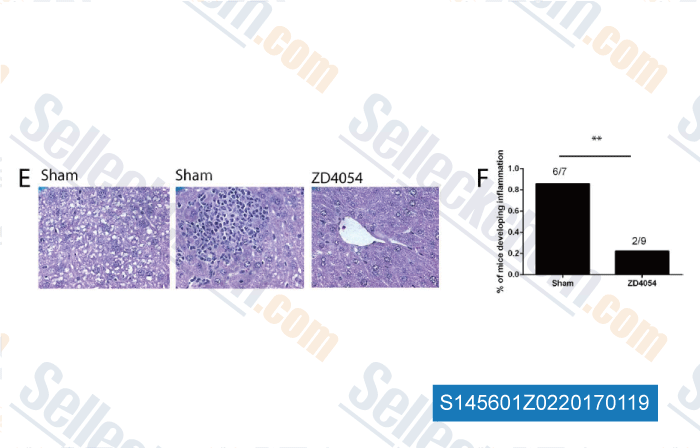|
Toll Free: (877) 796-6397 -- USA and Canada only -- |
Fax: +1-832-582-8590 Orders: +1-832-582-8158 |
Tech Support: +1-832-582-8158 Ext:3 Please provide your Order Number in the email. |
Technical Data
| Formula | C19H16N6O4S |
||||||
| Molecular Weight | 424.43 | CAS No. | 186497-07-4 | ||||
| Solubility (25°C)* | In vitro | DMSO | 24 mg/mL (56.54 mM) | ||||
| Water | Insoluble | ||||||
| Ethanol | Insoluble | ||||||
| In vivo (Add solvents to the product individually and in order) |
|
||||||
|
* <1 mg/ml means slightly soluble or insoluble. * Please note that Selleck tests the solubility of all compounds in-house, and the actual solubility may differ slightly from published values. This is normal and is due to slight batch-to-batch variations. * Room temperature shipping (Stability testing shows this product can be shipped without any cooling measures.) |
|||||||
Preparing Stock Solutions
Biological Activity
| Description | Zibotentan (ZD4054) is a specific Endothelin (ET)A antagonist with IC50 of 21 nM, exhibiting no activity at ETB. Phase 3. | ||
|---|---|---|---|
| Targets |
|
||
| In vitro | As Zibotentan specifically inhibits ETA-mediated antiapoptotic effects, but not ETB-mediated proapoptotic effects in human and rat smooth muscle cells, Zibotentan binds to endothelin A receptor (ETA) with high affinity with Ki of 13 nM, and has no affinity for endothelin B receptor (ETB) with IC50 of >10 μM. [1] Zibotentan treatment at 1 μM inhibits ET-1 induced mitogenic activity in ovarian carcinoma cell lines HEY and OVCA 433 secreting ET-1 and expressing ETA and ETB mRNA. [2] ZD4054 (1 μM) inhibits ET-1 induced EGFR transactivation in HEY and OVCA 433 cells. Zibotentan (1 μM) reverts ET-1 mediated epithelial-mesenchymal transition (EMT), by enhancing E-cadherin expression and promoter activity, and inhibiting vascular endothelial growth factor (VEGF) secretion and invasiveness in HEY and OVCA 433 cells. [3] Zibotentan also potently inhibits the basal and ET-1 induced cell proliferation in SKOV-3 and A-2780 cells, associated with the inhibition of AKT and p42/44MAPK phosphorylation, and with increased apoptosis through the inhibition of bcl-2 and activation of caspase-3 and poly(ADP-ribose) polymerase proteins. [4] | ||
| In vivo | Administration of Zibotentan at 10 mg/kg/day for 21 days potently inhibits the growth of HEY ovarian carcinoma xenografts in mice by 69% with no associated toxicity, which is in association with the blocking of cell proliferation evaluated by 37% inhibition of the Ki-67 expression, and the 62% inhibition of tumor-induced vascularization. Consistently, Zibotentan treatment significantly inhibits the expression of matrix metalloproteinase-2 (MMP-2) and VEGF, as well as the activation of p42/44 MAPK and EGFR, and potently enhances the expression of E-cadherin. [3] |
Protocol (from reference)
| Kinase Assay:[1] |
|
|---|---|
| Cell Assay:[3] |
|
| Animal Study:[3] |
|
References
Customer Product Validation

-
Data from [Data independently produced by , , Hepatology, 2016, 63(3):1000-12. ]
Selleck's Zibotentan (ZD4054) has been cited by 3 publications
| Targeting tumor-stroma communication by blocking endothelin-1 receptors sensitizes high-grade serous ovarian cancer to PARP inhibition [ Cell Death Dis, 2023, 14(1):5] | PubMed: 36604418 |
| Mutant p53 in concert with an interleukin-27 receptor alpha deficiency causes spontaneous liver inflammation, fibrosis, and steatosis in mice [Dibra D, et al. Hepatology, 2016, 63(3):1000-12] | PubMed: 26637970 |
| IL27 controls skin tumorigenesis via accumulation of ETAR-positive CD11b cells in the pre-malignant skin. [Dibra D, et al. Oncotarget, 2016, 7(47):77138-77151] | PubMed: 27738312 |
RETURN POLICY
Selleck Chemical’s Unconditional Return Policy ensures a smooth online shopping experience for our customers. If you are in any way unsatisfied with your purchase, you may return any item(s) within 7 days of receiving it. In the event of product quality issues, either protocol related or product related problems, you may return any item(s) within 365 days from the original purchase date. Please follow the instructions below when returning products.
SHIPPING AND STORAGE
Selleck products are transported at room temperature. If you receive the product at room temperature, please rest assured, the Selleck Quality Inspection Department has conducted experiments to verify that the normal temperature placement of one month will not affect the biological activity of powder products. After collecting, please store the product according to the requirements described in the datasheet. Most Selleck products are stable under the recommended conditions.
NOT FOR HUMAN, VETERINARY DIAGNOSTIC OR THERAPEUTIC USE.
